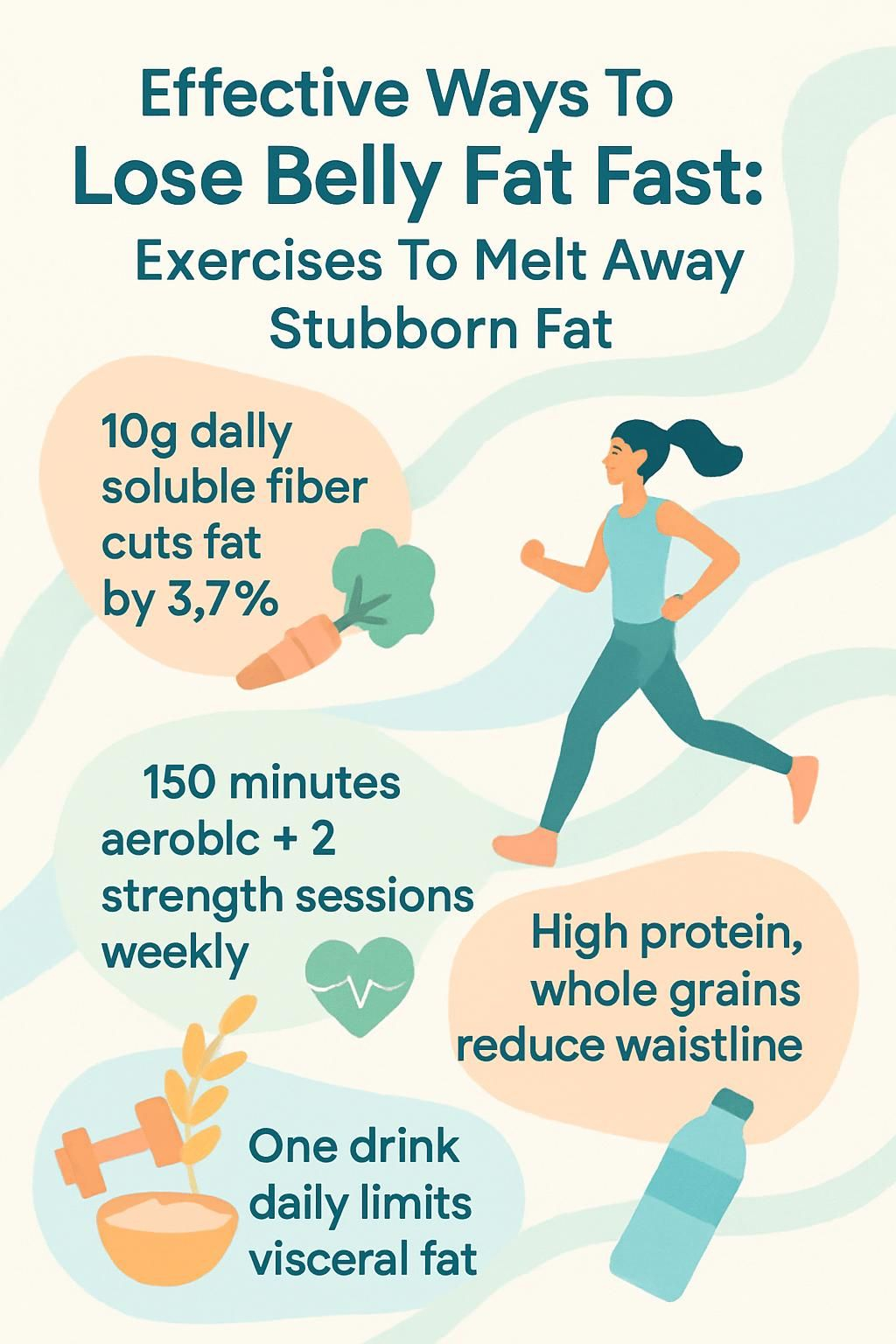Effective Ways To Lose Belly Fat Fast: Exercises To Melt Away Stubborn Fat
Our Nutrition Assistant AI Suite will transform your body. You will lose fat, get toned, and build muscle. Gain confidence and optimal health.
If you want to lose belly fat fast, you are not alone. Extra belly fat raises the risk of heart disease and type 2 diabetes. This guide shows safe, evidence-based ways to reduce stubborn abdominal fat with the right exercises, smarter food choices, and daily habits that stick.
Small changes add up. Start today, and the results will follow.
Key Takeaways
- Visceral belly fat, the deeper fat around organs, raises risk for heart disease and diabetes. Every extra 10 grams of soluble fiber per day linked to 3.7 percent less belly fat gain over five years (Hervik AK, 2019).
- At least 150 minutes of weekly aerobic activity, plus strength training two days per week, is most effective for reducing abdominal fat in adults (Friedenreich CM et al., 2015; Wewege MA, 2022).
- Diets higher in protein, whole grains, and nuts, and lower in refined carbs and added sugars, reduce waist size and improve insulin sensitivity (Framingham Heart Study; Veit M et al., 2021).
- Limiting alcohol to one drink daily for women and two for men helps curb visceral fat linked to metabolic disease (Wang L et al., 2023).
- Sustainable habits, such as quality sleep, stress management through yoga or meditation, hydration, and tracking food and exercise, create lasting results. Quick fixes and supplements alone do not work.

Types and Challenges of Belly Fat

Belly fat comes in two main forms, and both can affect health. Reducing it can be hard, but understanding how it behaves helps you choose smarter steps.
What Are the Different Types of Belly Fat?
Your body stores two major types of belly fat: subcutaneous fat and visceral fat. Subcutaneous fat sits just under your skin. You can pinch it. Visceral fat sits deeper in your abdomen around organs like the liver, pancreas, and intestines.
Visceral belly fat is metabolically active, meaning it affects hormones such as insulin. High levels raise the risk of type 2 diabetes, heart disease, fatty liver, stroke, some cancers, and abnormal blood fats. People with a normal BMI can still carry too much visceral fat, which is why waist size matters.
Several years ago, I measured a waist over 40 inches. After months of brisk walking, basic strength work, and core moves, my waist dropped by more than three inches. That change reflected a reduction in both surface fat and deeper visceral fat.
Why Is Belly Fat So Hard to Lose?
Your body tends to store more fat near the abdomen with age. Eating more calories than you burn leads to weight gain, and much of it often settles at the waist.
Genes help decide where your body stores fat. Many women notice more abdominal fat after menopause, since lower estrogen shifts fat storage. Lower muscle mass with age also slows metabolism, which makes fat loss harder. Even if your body weight stays steady, fat can still gather around the waist, raising the risk for insulin resistance and cardiovascular disease.
How Can Diet Help Lose Belly Fat?
A balanced diet supports fat loss, protects muscle, and helps control hunger. Focus on foods that fill you up without many empty calories.
How Does Soluble Fiber Aid Belly Fat Loss?
Soluble fiber forms a gel during digestion. This slows stomach emptying and helps you feel full longer. Common sources include oats, barley, legumes, apples, carrots, and leafy vegetables.
In a study of more than 1,100 adults, every additional 10 grams of soluble fiber per day was associated with 3.7 percent less belly fat gain over five years. Filling half your plate with fruits and vegetables adds fiber with few calories. For me, oatmeal with berries kept me full until lunch and cut mid-morning cravings for processed snacks.
Small, daily changes in fiber add up to big wins at your waist.
Higher fiber diets help with long-term energy balance and lower body fat. If you want realistic ways to reduce stubborn belly fat, start by adding soluble fiber each day.
Which High-Protein Foods Should I Eat?
Protein controls appetite and protects muscle during weight loss. Research shows higher protein intake can support fat loss and a healthy BMI.
- Eggs at breakfast support fullness hormones and reduce later snacking.
- Lean chicken or turkey offers high-quality protein with less saturated fat.
- Salmon or mackerel twice a week supply protein and omega-3s for heart health.
- Greek yogurt or cottage cheese keeps you satisfied and adds calcium.
- Whey protein after a workout absorbs fast and helps protect muscle.
- Black beans or lentils add plant protein and fiber for steady energy.
- Almonds or other nuts make a protein-rich snack that curbs hunger.
- Tofu or tempeh provide complete plant protein for meat-free meals.
Why Reduce Refined Carbs and Sugary Foods?
Cutting refined carbs and added sugars helps you lose weight and reduces visceral fat. Whole grains are linked with smaller waists. Refined grains like white bread and pastries cause quick blood sugar spikes and push the body to store more fat in the abdomen.
High sugar intake raises the risk of heart disease, type 2 diabetes, and fatty liver (Veit M et al., 2021). Too much added sugar can also inflame the body and lead to insulin resistance in kids, which raises future obesity risk.
Swap sugary drinks for water. Choose steel-cut oats over sugary cereal. These swaps help you feel better and stay full without extra calories.
Quick Data Reference Table:
| Food or Habit | Effect on Belly Fat | Supporting Study |
|---|---|---|
| Refined carbohydrates | Increases abdominal fat | Framingham Heart Study |
| Whole grains | Reduces abdominal fat | 17% lower risk vs. refined grain eaters |
| Added sugars and sugary drinks | Higher belly and organ fat | Veit M et al., 2021 |
| Sugary diet in childhood | Inflammation and higher obesity risk | López-Alarcón M et al., 2014 |
Replacing refined carbs with whole grains supports fitness, steadier blood sugar, and calmer hormone swings after meals.
What Are Trans Fats and Why Avoid Them?
Trans fats are created when companies hydrogenate oils, often labeled as partially hydrogenated oils. Many packaged snacks, fried items, and some margarines contain them.
Studies show trans fats raise inflammation and promote belly fat storage. They also raise the risk of heart disease and prediabetes. I began checking labels and stopped buying foods with partially hydrogenated oil. Focusing on whole foods and nuts helped my waist shrink and energy improve.
How Does Alcohol Affect Belly Fat?
Alcohol adds extra calories and can drive fat storage around the waist. Heavy intake raises visceral fat and metabolic risk. In research, people with lower alcohol intake had less abdominal fat.
Guidelines suggest no more than two drinks per day for men and one for women. Cutting back supports heart health and makes it easier to stay in a calorie deficit.
Why Is Staying Hydrated Important?
Hydration supports metabolism and appetite control. Drinking water before meals can help you eat fewer calories. Replacing sweet drinks with water or unsweetened tea lowers daily sugar and supports waist loss.
I traded soda for sparkling water with lemon. Cravings faded, and my energy felt more stable. Proper hydration also supports the liver and kidneys, which help process fats.
Healthy Hydration Choices
| Beverage | Calories per 8 oz | Impact on Belly Fat |
|---|---|---|
| Water | 0 | Best choice |
| Unsweetened iced tea | About 2 | Supports fat loss |
| Sparkling water with lime | 0 | Reduces cravings |
| Sugary soda | About 100 | Promotes fat gain |
Water keeps blood moving through your vessels as you train. Even one fewer sweet drink per day can speed progress and support overall health.
Best Exercises to Burn Belly Fat
Diet plus exercise works best for trimming your waist. Think of movement as your daily nudge toward better health.
What Are Good Aerobic Exercises for Belly Fat?
Aerobic exercise burns calories and helps shrink visceral fat. Aim for at least 150 minutes per week.
- Brisk walking reduces waist size. Try 30 minutes, five days per week.
- Jogging raises your heart rate and boosts calorie burn.
- Cycling works large leg and core muscles and supports a calorie deficit.
- Swimming trains the whole body and is joint friendly.
- Dance classes increase your breathing rate and make workouts fun.
- Rowing builds strength in the legs and arms while burning many calories.
- Hiking adds hills and variety that challenge your muscles.
In postmenopausal women, similar visceral fat loss occurred at 150 or 300 minutes per week. Choose a schedule you can maintain, then build from there.
How Does High-Intensity Interval Training Work?
High-intensity interval training, or HIIT, alternates short bursts of hard effort with brief recovery. Examples include 30 seconds of sprinting followed by one minute of walking.
Research shows HIIT reduces body fat effectively and suits busy schedules. I often felt more spent after 15 minutes of intervals than after a long, slow run. Three HIIT sessions per week can help lower visceral fat over time.
Why Is Resistance Training Effective?
Resistance training increases muscle mass. Muscle burns more calories at rest than fat. This helps you keep weight off while eating a bit more.
A 2022 meta-analysis found that resistance training reduces total body fat in adults. It also improves outcomes in people with prediabetes, type 2 diabetes, or fatty liver. Combining lifting with cardio led to the greatest waist reduction in overweight teens.
Start with basic moves and proper form. Ask a healthcare provider or qualified trainer if you are new to lifting or have medical concerns.
Which Core Exercises Target Belly Fat?
Core training builds strength and posture, which supports every workout. It cannot spot-reduce fat, yet it improves muscle tone while your total body fat drops.
- Planks build core stability. Hold 30 to 60 seconds with a straight line from head to heels.
- Crunches work the front abdominal muscles. Lift your shoulders gently and squeeze at the top.
- Bicycle crunches hit the obliques. Move with control, elbow to opposite knee.
- Leg raises challenge the lower abs. Keep your lower back pressed into the floor.
- Mountain climbers raise your heart rate and fire the core.
- Russian twists train the obliques. Keep the motion smooth and the spine tall.
- Bird dogs improve balance and back health. Reach opposite arm and leg, pause, then switch.
Use core work to support better movement and protect the spine as you lose fat through diet, cardio, and strength training.
How to Combine Cardio and Strength Training?
Mixing cardio with resistance work speeds fat loss and supports a higher metabolism.
- Alternate aerobic days with lifting days to increase weekly calorie burn.
- Target at least 150 minutes of moderate cardio each week for steady progress.
- Lift weights at least twice weekly to reduce muscle loss during weight loss.
- Use short HIIT blocks alongside lifting to boost post-workout calorie burn.
- Rotate activities to avoid plateaus and keep training interesting.
- Track minutes, sets, or weights in an app to stay consistent.
- Pair training with a balanced eating plan that you can keep long term.
Lifestyle Changes for Lasting Belly Fat Loss
Daily habits shape your waist as much as workouts do. Treat them as guardrails for your goal.
How Can Managing Stress Help?
Chronic stress raises cortisol, a hormone linked with more belly fat and stronger cravings. Larger waistlines often track with higher cortisol responses to stress.
Evidence shows both diet and long-term stress contribute to abdominal obesity. Simple practices like yoga, breathing drills, or short meditations can lower stress. After two months of short daily yoga, I felt calmer and found it easier to choose better foods.
Managing tension also gives your digestive system time to work well without hormonal spikes that can trigger overeating.
Why Is Quality Sleep Important?
Short sleep raises the odds of weight gain, and much of it lands at the waist. In a study of over 68,000 women, those sleeping fewer than five hours gained more than those sleeping seven or more.
Aim for about eight hours of quality sleep most nights. Poor sleep also links to higher visceral fat, especially with sleep apnea. Adequate rest steadies hunger hormones, makes exercise feel easier, and reduces cravings for sugary snacks.
How to Track Food and Exercise Effectively?
Use a food diary or app to log calories and nutrients. Tracking highlights patterns that stall progress, such as weekend snacks or large sugary drinks.
Log your workouts too. Seeing progress in minutes walked or weights lifted builds momentum. Even simple notes about snack sizes can help you hit a calorie deficit more consistently.
How Does Support Influence Success?
People around you can lift you up or pull you off course. Supportive friends, groups, or a workout buddy make healthy choices easier.
A partner can check in, join your walks, or cook simple, healthy meals with you. Professional coaching can help when plateaus hit or when you need form feedback. Consistent encouragement keeps small wins coming.
Additional Tips to Enhance Belly Fat Loss
Smart add-ons can nudge your results forward. Use them to reinforce your core plan of diet and exercise.
What Is Intermittent Fasting and Does It Help?
Intermittent fasting cycles between eating and fasting windows. Popular methods include 16:8 daily fasting or one to two full fasting days per week.
Studies show intermittent fasting, especially with higher protein intake, can reduce visceral fat compared with standard diets. Women may see changes in blood sugar during fasting, so discuss any plan with a healthcare professional if you have medical conditions.
I tried a 16:8 schedule for a month and found it easier to avoid late-night snacking. It also helped me plan protein-rich meals during my eating window.
How Do Probiotic Foods Affect Belly Fat?
Probiotics are helpful bacteria found in foods like yogurt, kefir, and fermented vegetables. They support a healthy gut, which may influence weight management.
Some strains, such as certain Lactobacillus types, may modestly reduce belly fat when part of a balanced diet. Effects vary by strain and person. Consider discussing probiotic supplements with your clinician before starting, especially if you have health issues.
Summary: Probiotic foods can support digestion and may help with small reductions in belly size. Results are modest and depend on consistent habits.
Why Include Fatty Fish in Your Diet?
Fatty fish like salmon, herring, sardines, mackerel, and anchovies offer high-quality protein and omega-3 fats. These nutrients support heart health and may reduce harmful visceral fat, especially in people with fatty liver conditions.
Try two to three servings per week. Plant-based omega-3s from algae supplements can help if you do not eat fish. After I added salmon twice a week, my workouts felt stronger and my snack cravings fell.
How Does Limiting Sugary Drinks Help?
Sweet drinks, including soda and many juices, deliver a lot of sugar with little fullness. An 8-ounce glass of unsweetened apple juice has about 24 grams of sugar, much of it fructose.
Research shows fruit juice behaves like sugary drinks in the body. These beverages promote visceral fat and raise diabetes risk. Cutting them can trim inches and help control cravings.
Why Focus on Sustainable Changes?
Fast fixes rarely last. Ultra-processed foods encourage overeating and weight regain. Simple swaps, like fruit or nuts instead of refined snacks, support better blood sugar and long-term health.
Blending cardio, lifting, and balanced meals beats one-off tactics. Limiting alcohol removes empty calories that cluster around your waist. Sustainable habits protect your progress without extreme rules.
Summary: Choose whole foods, move consistently, sleep well, and keep stress down. These steady practices reshape your waist and support better health.
Common Misconceptions About Losing Belly Fat
Some common myths slow progress. Knowing the truth helps you focus your effort where it matters.
Is Spot Reduction Possible?
No. Doing hundreds of crunches builds muscle under the fat, but it does not pull fat from that exact spot. The body reduces fat systemwide.
For a smaller waist, pair regular aerobic exercise with strength training and a steady eating plan. Supplements and single-machine routines cannot melt belly fat by themselves.
Can Supplements Alone Reduce Belly Fat?
Supplements cannot replace healthy habits. Some may fill nutrient gaps, but they do not target belly fat directly.
Talk with a healthcare professional before starting any supplement, especially if you take medicines or have a health condition. I once added a daily fiber supplement, but my waist changed only after I also improved my diet and workouts.
Summary Table:
| Method | Effectiveness | Notes |
|---|---|---|
| Supplements alone | Low | No direct impact on belly fat |
| Exercise plus diet | High | Needed for waist size change |
| Professional guidance | Helpful | Consult before using supplements |
Use credible sources and be cautious of products promising fast results without effort.
Are Crash Diets Effective?
Crash diets can lead to fast loss at first. Much of that is water and muscle. They can slow metabolism and stress your body.
Most people regain the weight after stopping. Extreme calorie cuts often lead to more belly fat later. Steady, manageable choices produce better results and protect your health.
Frequently Asked Questions
Here are clear answers to common questions about reducing belly fat safely.
Which Exercises Burn Belly Fat Fastest?
HIIT, with short all-out bursts and brief rests, can shrink your waist faster than steady cardio. Aerobic work like brisk walking, running, or cycling also burns many calories.
Strength training adds muscle, which raises resting calorie burn. Core work helps posture and performance, but it must be paired with full-body training. Intermittent fasting may help some people when combined with exercise and a balanced diet.
Can Belly Fat Be Lost in One Week?
Rapid belly fat loss in seven days is not realistic or safe. A healthy rate is about one to two pounds per week across the body.
Quick drops often reflect water loss, not true fat change. Focus on balanced eating, fewer sweet drinks, steady workouts, and good sleep for safer progress.
What Foods Help Reduce Belly Fat?
Soluble fiber foods, like oats, beans, and apples, keep you full longer. An extra 10 grams per day linked to less belly fat gain over time.
High-protein choices, such as eggs, chicken breast, Greek yogurt, and nuts, support muscle and reduce cravings. Fatty fish like salmon and mackerel add omega-3 fats that target harmful belly fat. Probiotic foods, like kefir and sauerkraut, may support gut health and modest weight control.
Green tea contains catechins that support calorie burn. I swapped afternoon snacks for Greek yogurt with berries and stayed satisfied until dinner.
Conclusion
To lose belly fat, combine a balanced diet rich in protein and soluble fiber with regular aerobic exercise, strength training, and simple core work. Build guardrails with stress control, solid sleep, and steady hydration. Keep alcohol, refined carbs, sugary drinks, and trans fats low for a clear edge.
Support from friends or a coach can keep you consistent. If you have a medical condition, are pregnant, or take medication, consult a healthcare professional before changing your diet or exercise routine.
Make a few smart choices each day. Your waistline and health will reflect the effort you invest.
FAQs
1. What exercises help reduce belly fat fast and target the waistline?
Crunches, planks, and aerobic activities like brisk walking or cycling can help burn calories and shrink your waistline. Studies show that combining these movements with a balanced diet leads to better results for losing abdominal mass.
2. How does alcohol affect efforts to lose stubborn belly fat?
Alcohol is high in empty calories and may slow metabolism in organs such as the liver. Research links regular drinking with increased storage of body mass around the abdomen, making it harder to melt away stubborn fat.
3. Are certain foods more effective for burning belly fat than others?
Yes, eating nuts like almonds or walnuts provides healthy fats and protein that support weight loss without adding extra pounds around your midsection. Evidence suggests diets rich in fruits, vegetables, lean proteins, and whole grains are linked to lower abdominal fat levels.
4. Can personal experience support evidence-based methods for losing belly fat?
After switching from processed snacks to fruit and nut mixes while increasing daily crunch repetitions, I noticed a visible reduction in my waistline within weeks. This aligns with research showing consistent exercise paired with nutritious food choices helps decrease excess abdominal mass over time.
Summary: Targeted exercises such as crunches combined with healthy eating habits including nuts can reduce unwanted pounds at the waistline; limiting alcohol also supports this goal according to scientific studies as well as personal accounts.







